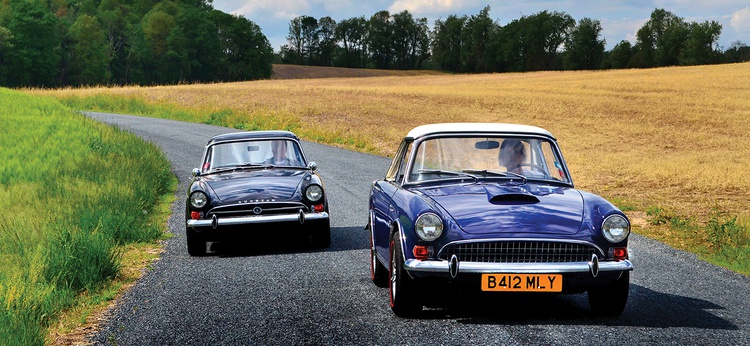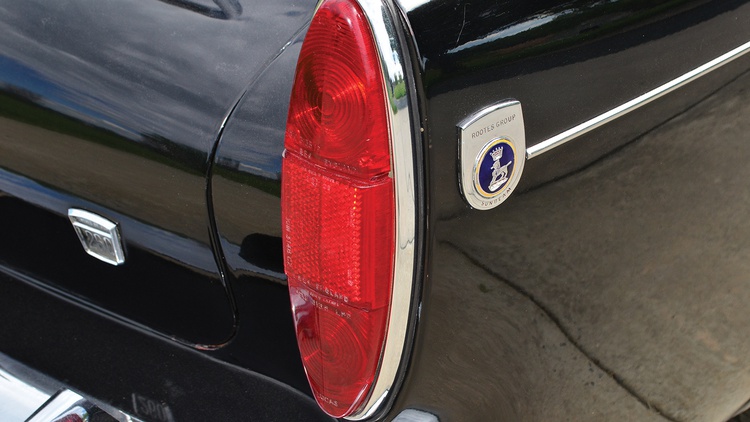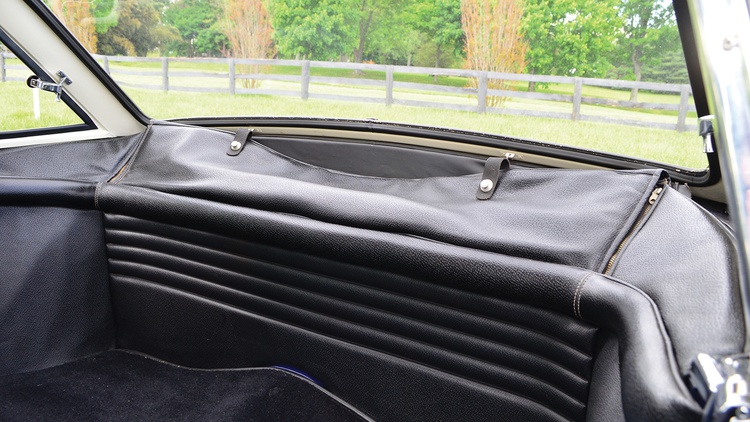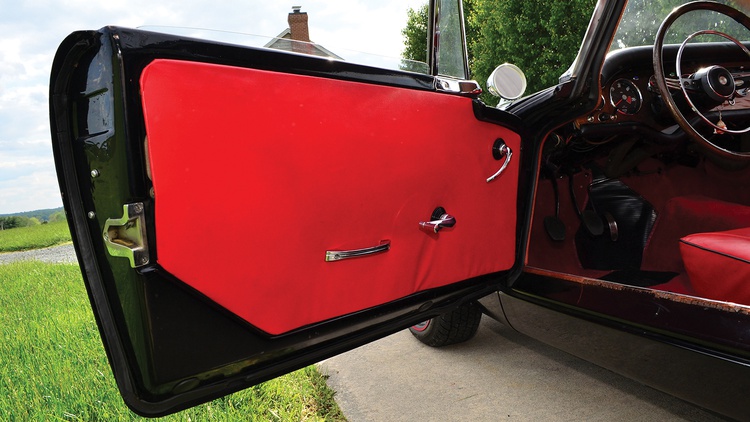Mark 1 and 2
Interesting comparison from Classic Motorsport
Comparing Sunbeam Tigers: Mk I vs. Mk II
This article is from a past issue of the magazine. Like stories like this? You’ll see every article as soon as it’s published, and get access to our full digital archive, by subscribing to Classic Motorsports. Subscribe now.
Story and Photos by Tom Suddard
Why are Cobras worth so much? Simple: because you and everyone else wants one.
Fortunately, there’s a more cost-effective substitute, the Sunbeam Tiger. What’s a Tiger? It’s the Cobra’s formula applied to another small British sports car, the Sunbeam Alpine. The Cobra and the Tiger prototype were even built by the same irascible Texan, Carroll Shelby. Tigers are considered the more comfortable and refined of the two, so they’re perfect for road rallies and weekend drives. Plus, they’re more than affordable compared to a million-dollar Cobra: A nice Tiger can be had for a touch more than $50,000.
“Great,” you’re probably thinking, “I’ll fire up eBay Motors and buy one.”
Not so fast. You’ve got a big decision to make.
Tigers can be split into three very distinct groups: early cars, worth as much as $118,000 according to Hagerty; late cars, worth as much as $205,000; and transition cars, worth somewhere in between. Why the difference in value? Is a late Tiger really twice as good as an early one? We drove two concours-correct examples owned by Kim Barnes to find out.
Eeny, Meeny, Miny, Moe

The Tiger’s first model year was 1964, but its story starts with the Sunbeam Alpine, which went on sale in 1959. The Alpine was a better-built competitor of the Triumph TR3 and MGA. Rootes Group, Sunbeam’s parent company, created it to capture the huge demand for British sports cars in the United States. The car had a few tricks up its sleeve to win America’s attention, like roll-up windows, disc brakes and unibody construction.
Unfortunately, Sunbeam was late to the game. By the time the heavier, slower Alpine became available, many buyers had already made up their minds and bought Triumphs, Austin-Healeys and MGs. Alpines weren’t bad cars, but they weren’t terribly exciting–and neither were their sales. Until Ian Garrad came along, that is.
Catch a Tiger by the Toe

Garrad headed Rootes Group’s West Coast distribution, and he had an idea to revitalize the Alpine: Shove Ford’s new 260-cubic-inch V8 under the hood. Garrad commissioned two prototypes, one to be built by Ken Miles of Shelby American and another by Shelby American proper. Miles, whose objective was to simply find out if the swap was feasible, hastily finished his version in a few weeks.
Unlike the eventual production car, his prototype was cheap and crude: It sported a two-speed automatic, kept the Alpine’s recirculating ball steering, and was basically just bodged together.
This down-and-dirty prototype was fantastic, at least in Garrad’s mind, since it proved his concept had legs. Of course, once the second prototype came out, it quickly became the star. After spending considerably more money and time, Shelby American unveiled a fairly polished V8-swapped Alpine, this time with rack-and-pinion steering and the four-speed manual that would eventually make its way to the production line.
Garrad finally felt confident enough to tell the company chairman about his experiment, so he headed over to England to let Lord Rootes himself take a spin in the V8 Alpine. Rootes loved it and called Henry Ford to order lots of V8 engines.
Now, you’re probably expecting to read about how Shelby’s prototype was further polished into a production-ready automobile before its debut for the 1964 model year. Fun fact: It wasn’t.
To produce Tigers, Sunbeam basically sent Alpine bodies down a production line full of hammers, stick welders and V8 engines. The easiest way to spot a fake Tiger? Look for quality workmanship, since real Tigers emerged from the factory sporting a slew of dents, cuts and nasty-looking welds. Chassis modifications that weren’t for the sole purpose of shoehorning the V8 under the hood were few and far between. Tigers even shared the Alpine’s brakes.
The Tiger was released in the last gasp of the British automobile industry, and it valiantly dug in its claws and held on as long as it could during Rootes Group’s transition to Chrysler. Although it couldn’t halt the decline of its parent company, it did manage to remain an enthusiast favorite for decades to come.
Wait, What About Racing?

Yes, we can hear you: “Cobras are so revered because they won so many races. What have Tigers ever won?”
Okay, that is a valid point. Tigers don’t have anywhere near the track record of Shelby Cobras. But that doesn’t mean they all stayed home to watch the race on TV.
Tigers were great drag racing cars, and they won a few championships in the mid-’60s. They were also great rally cars, winning first in class at the 1964 Geneva Rally, the 1965 Monte Carlo Rally and the 1965 International Scottish Rally. A Tiger even took outright victory at the 1965 International Police Rally. Two fastback-bodied Tigers also attacked the 1964 24 Hours of Le Mans, though they didn’t fare well; overheating issues knocked them out of the race.
Tigers won races stateside, too. Ian Garrad, who first envisioned the V8 Alpine, hired Shelby to build and race a Tiger with the SCCA. After one season and a few wins, factory support shifted to Doane Spencer of the Hollywood Sport Cars team. Under his leadership, Tigers spent 1965 and 1966 racing against Shelby GT350s and Chevrolet Corvettes before changing SCCA classes rendered the car uncompetitive.
Tiger Values
Tiger values have been rising quickly, with cars worth twice as much as they were just two years ago. We asked Drew Alcazar, CEO of Russo and Steele collector automobile auctions, what he thought about the current Tiger market.
Alcazar started off with a disclaimer: “Since the Tiger has been an inexpensive car for so long, the conditions vary widely, thus it is tough to place exact values on these cars. Sure, there are Tigers worth six-plus figures, but most are still under-restored or highly modified cars, and that throws off any consistency in values.”
Because of this, he argues, the Tiger appeals to more of a niche market. “Having owned three myself, I see the Tiger as more of an enthusiast car than a ‘collector car’ by definition,” he says. “By that, I mean if someone was going to make a list of the top 25 or even 100 cars to have in a premier collection, the Tiger probably is not on that list.”
According to Alcazar, getting top dollar for a perfect Tiger is much harder than getting fair money for a fun driver: “Most general car collectors don’t know enough about the cars to know the nuances of an early versus a later car, and therefore don’t know about the difference in values. It will take some time for this knowledge curve to catch up.”
The bottom line? The Tiger market is still unstable, but there is no denying that these cars are selling for more than ever before.
Mk I Driving Impressions

Let’s just say this right out of the gate: If you’re going to buy a MkI Tiger and plan to leave it stock, don’t read any period reviews. Just don’t. Put down that vintage issue of Autocar, and especially avoid the part where they write, “The Tiger is a rapid and exceedingly enjoyable car to drive.”
Why? In all honestly, early Tigers are fairly slow by modern standards. In 1964, a 2500-pound car with 164 horsepower was unheard of, but these days a Miata will destroy one in a straight line. In the corners, well, let’s not talk about corners. Tigers handle like derailed trains, and sound about the same while they’re doing it.
What early Tigers are best at, instead, is touring. They’re a gentleman’s sports car, but the Alpine’s wheezy four-banger everyone expects is replaced with a docile, torquey V8. They’re cars you could spend all day in, and build quality and comfort are definitely a notch or two higher than the average Triumph.
Mk II Driving Impressions

Comparing engine displacements can be deceiving. Take the early Tiger’s 260 cubic inches versus the later car’s 289. What’s 29 cubic inches really worth? It’s basically like bolting a lawn mower engine on top of a Mk I Tiger’s, right? Well, no.
In fact, the 289 is transformative. That 36 extra horsepower and 24 extra ft.-lbs. of torque somehow turn the knobs to 11, making the Mk II Tiger feel legitimately fast. The numbers back that up, too: Zero to 60 in 7.5 seconds allows this one to keep pace with most modern sports cars, though it only runs a 15-second quarter mile. From the driver’s seat, the other noticeable difference between the two cars is ventilation. Mk IA and Mk II Tigers have cowl vents that make them much more comfortable on hot summer days.
Is the drop in build quality noticeable? We think so. Call us old-fashioned, but we love the leaded body seams and rounded corners that make the earlier Tigers such a pain to assemble and restore. And although the Mk II’s vinyl tonneau is much more functional, the Mk I’s impractical metal version is so nice to look at.
Spot the Differences
By this point, few Tigers still have their stock engines–remember, for decades these were just used cars, and drag racers loved them. If originality isn’t important to you and cost is no object, we suggest picking a Tiger based on the little details rather than which engine it originally received from the factory.
Fender Badges

Mk I Tigers had “Powered by Ford 260” fender badges, while Mk II Tigers wore “Sunbeam V8” badges as well as tiny Chrysler pentastars at the bottom of each front fender.
Mk II cars were produced after Chrysler acquired Sunbeam’s parent company, Rootes Group, and the manufacturer wasn’t comfortable having “Ford” written on the side of its car.

Deck Lid Badges

Mk I Tigers had “Sunbeam” spelled out across the deck lid, while Mk II cars only had “Tiger” written across the left corner.

Chrome Trim

Early cars had a chrome beltline, but later cars traded that piece for chrome trim along the bottom of the body and wheel wells.

Dashboards

The gauges had slightly different faces, while the ammeter on later cars gained 10 amps of additional range thanks to the more powerful alternator.

Door Gaps

Mk I Tigers featured beautifully radiused door openings, with each body seam filled with lead. To cut costs, Mk II Tigers had squared-off openings, with obvious seams.

Engines

Under the hood, early and late Tigers looked almost identical. The most obvious difference was the generator, which was replaced with an alternator in Mk II cars.

Grilles

Early Tigers wore classic, “one bar” chrome grilles and an eyebrow over each headlight.
Mk II Tigers wore egg crate grilles and streamlined, eyebrow-free headlights.

Late Tigers also had an oil cooler below the radiator, which was a welcome addition to these notoriously hot-blooded cars.
Trunks

All Tigers had a spare tire well, just like the Alpines they were based on. The Tiger’s spare was too wide to fit in it, though, so the well sat unused in early cars.
The Mk II’s housed a fuel pump.

Seats

Early Tigers came with a range of interior colors (including the bright red on this example), but by the Mk IA, textured black vinyl was the only option. To further cut costs, unnecessary seams were scratched in favor of welded accents.

Taillights

The factory also saw the taillights as a prime cost-cutting opportunity.
To ease the assembly of later Tigers, exposed screws held on each lens.

Tonneaus

Mk I Tigers had intricate pieces of sheetmetal that folded into a tonneau cover when the top was down. These looked great, but unfortunately they were finicky, easy to scratch, and expensive to build.
Mk IA and Mk II Tigers went to a more traditional vinyl tonneau.

Door Panels

Door panels in later cars gained a bit of an armrest on top, some style lines and more texture. Early door panels often looked homemade–they consisted of just one sheet of cardboard and one piece of vinyl.

Real or Fake?
Like any faster variant of a pedestrian car, Tigers are often replicated. Alpines are cheap and plentiful, and shoving a V8 into one isn’t exactly rocket science. Tiger VIN plates are only riveted on, meaning it’s easy (though illegal) to transplant them.
Fortunately, it’s fairly easy to spot the fakes. Here are a few features and quirks that you’ll find on real Tigers but not many Alpine-based replicas:
• Rack-and-pinion steering.
• Dent on inner right fender for generator clearance.
• Drilled-out spot welds on inner fenders where bracing used to be.
• Cut and notched front subframe with stick-welded reinforcements.
• Panhard bar on rear suspension.
• Chrome strip down either side.
• Access door on package shelf for fuel pump (Mk I and IA only).
• Dual exhaust hangars.
• Trunk-mounted battery, with wooden false floor and clips to hold it up during tire changes.
Not sure of a car’s legitimacy? Contact the Sunbeam Tiger Owners Association, which maintains a registry of authenticated cars and has a formal procedure for inspecting them. Tigers East/Alpines East can also help authenticate a car.
This article is from a past issue of the magazine. Like stories like this? You’ll see every article as soon as it’s published, and get access to our full digital archive, by subscribing to Classic Motorsports.
